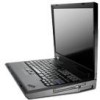IBM 2388 Hardware Maintenance Manual - Page 37
Power, management
 |
UPC - 000435123473
View all IBM 2388 manuals
Add to My Manuals
Save this manual to your list of manuals |
Page 37 highlights
Related service information Both user HDP and master HDP will have been removed. Power management To reduce power consumption, the computer has three power management modes: screen blank, standby, and hibernation. Screen blank mode Screen blank mode has three variants, as follows: 1. If you are using the ACPI operating system and you press Fn+F3, v The LCD backlight turns off. v The hard disk drive motor stops. 2. If the time set on the "Turn off monitor" timer in the operating system expires, v The LCD backlight turns off. To end screen blank mode and resume normal operation, press any key. Standby mode When the computer enters standby mode, the following events occur in addition to what occurs in screen blank mode: v The LCD is powered off. v The hard disk drive is powered off. v The CPU stops. To enter standby mode, press Fn+F4. Note: You can change the action of Fn+F4, if you are using the ACPI operating system. In certain circumstances, the computer goes into standby mode automatically: v If a "suspend time" has been set on the timer, and the user does not do any operation with the keyboard, the TrackPoint, the hard disk, the parallel connector, or the diskette drive within that time. v If the battery indicator blinks orange, indicating that the battery power is low. (Alternatively, if Hibernate when battery becomes low has been selected in the "Power Management Properties" window, the computer goes into hibernation mode.) Hibernation mode In hibernation mode, the following occurs: v The system status, RAM, VRAM, and setup data are stored on the hard disk. v The system is powered off. General descriptions 33















